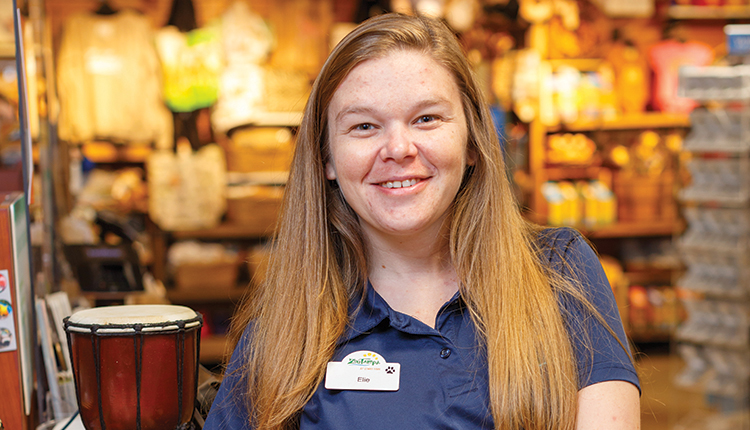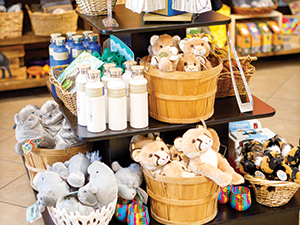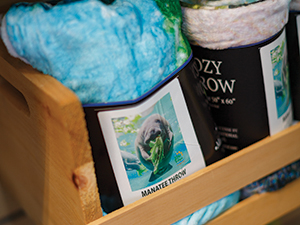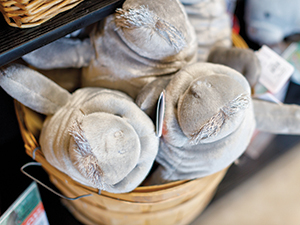Retail with a purpose |
| By Brooke Bilyj |
Gift shops throughout ZooTampa at Lowry Park support the zoo’s mission of animal conservation and rehabilitation. With 56 acres of habitats that house more than 1,000 animals, ZooTampa at Lowry Park provides plenty of opportunities for people to connect with the natural world. Nearly 1 million guests visit the zoo annually for close-up animal encounters like feeding the lorikeets, touching a giant tortoise or splashing with the stingrays. As part of its vision “to protect and preserve wildlife,” ZooTampa promotes conservation and rehabilitation through its diverse programming, with an emphasis on saving endangered and threatened species like the local Florida manatee. Since opening the David A. Straz, Jr. Manatee Critical Care Center in 1991 — the first critical care center of its kind — the zoo has treated an excess of 500 ill and injured manatees and released more than 280 of them back into native waters. As a non-profit organization that is 93% self-funded, ZooTampa relies on ticket sales, memberships and donations to support its educational programs, animal care and conservation efforts. Retail gift stores throughout the park also play a major role in funding the zoo’s operation — whether by selling conservation-themed merchandise, collecting donations for manatee rehabilitation or promoting animal adoptions. Attracting attentionWith six permanent retail locations scattered throughout the park, plus several seasonal pop-ups and mobile carts, visitors have multiple opportunities to shop for gifts and merchandise as they explore the zoo. The largest gift shop, Nature’s Kingdom, sits inside the zoo’s main entrance. “That’s the first place that people come when they come in, and it’s also the last place that they go [before] they leave,” Johnson says.  ZooTampa’s main gift shop, Nature’s Kingdom, has a wide variety of souvenirs. Retail displays are constantly refreshed so visitors always have new merchandise to check out. Sunscreen, sunglasses, hats and stroller rentals are displayed outside of the main gift shop so guests can quickly grab the items they’ll need before they start their day at the zoo. As they walk through other sections of the park, visitors encounter smaller, open-air retail shops along the way with merchandise themed to each geographic area. For example, the shop in the Africa section sells African-themed gifts and toys, including the zoo’s best-selling plush giraffe. Another shop near the splash pad, located in the Australian section of the zoo, sells children’s bathing suits and towels, while the store in the Florida-themed area sells items inspired by native wildlife alongside paintings created by local artists. Each store staffs one to three employees each day, depending on scheduled events and expected attendance. The total retail workforce is about 40, including full-time staff and part-time seasonal help. “We just built a secondary warehouse right next door [to the main warehouse], because we’ve grown so much in the last few years,” Johnson explains. “We were just popping at the seams.” In fact, ZooTampa hit its highest annual attendance ever during the 2021 season, welcoming more than 1 million visitors. Johnson credits the zoo’s rising popularity to being featured on the Nat Geo Wild television series, “Secrets of the Zoo: Tampa,” which aired in 2020. She says the extra attention helped drive record-breaking attendance throughout the pandemic as people flocked to the zoo’s outdoor attractions. “During the pandemic, people needed something to do,” Johnson says. “Being an open-air facility where people can walk around outdoors and still social distance, we provided that for them [and so] people really enjoyed coming out here.” Plus, with new animals and special events throughout the year, she says, “People keep coming back.” Providing reasons to shopAs zoo attendance continues to grow, Johnson and her merchandising team keep the retail displays fresh — especially inside the main gift shop — to give guests more reasons to shop every time they visit. Members and returning visitors comprise approximately 65% of the zoo’s annual attendance. “We have a huge member base, and we also have a program [where people can] pay for a day and come back all year,” Johnson explains. To keep shoppers engaged, the retail stores stock merchandise that appeals to first-time and returning visitors alike, while serving a wide range of age groups. “Our primary demographic is families with toddler-age children, so our number one seller by far is plush,” Johnson says. “We also have an entire wall that is just plush, and we’ll also throw plush into whatever display we are doing.” Besides stuffed animals, the zoo’s next biggest sellers are T-shirts for children and adults. “The T-shirts appeal to both the one-time visitor and the repeat visitor because they want to have something that says our name on it,” she says.  Items depicting manatees are especially popular at the zoo, which has Manny T as its lovable mascot. A range of other items that share a conservation message are also available. The back of the main gift store is geared toward children, with wildlife-inspired plush, toys, shirts and books. The front of the store features giftware, mugs, shot glasses and jewelry for adults, with an emphasis on beach-themed decor and signage. Coastal ornaments sell well all year long, Johnson says. During December, the zoo also hosts Christmas in the Wild every Friday and Saturday night with a pop-up shop that sells customized ornaments and animal-themed gifts. There’s also mobile carts that sell bubble wands and glow-in-the-dark toys to keep kids entertained after dark. Guests might be able to find exotic stuffed animals and similar toys from online retailers — perhaps even at cheaper prices — but the zoo’s exclusive merchandise helps remind shoppers of their unique and unforgettable experiences at ZooTampa. “We don’t have any direct competitors, but we do try to maximize our sales and get as many visitors [as possible] to come in and make a purchase,” Johnson says. “Having exclusive items that you can only get at the zoo is super important — whether it’s items that specifically say our name on it or plush that is created specifically for us — because obviously, you can’t get that anywhere else.” Supporting conservationAlthough the retail displays change seasonally, Johnson maintains a constant theme of conservation in line with the zoo’s focus. To celebrate Manatee Awareness Month in November, for example, the main display in Nature’s Kingdom honors the lovable sea cow with custom plush exclusively designed to depict the zoo’s mascot, Manny T — along with manatee T-shirts, throw blankets and stainless steel water bottles. “If we’re doing a manatee theme, we’ll [display] items to replace single-use plastics — like reusable tote bags, straws, and water bottles — and put some signage in there about the importance of keeping these items out of the ocean,” Johnson says. “We have some signs explaining that the plush and the T-shirts are made from recycled water bottles, to tie it all together.” The zoo’s goal is to educate people about how they can impact the oceans by making these simple swaps.  Eco-friendly plush is ZooTampa’s biggest seller thanks to families with toddlers. The plush comes in biodegradable packaging with soy-based ink and recyclable hang tags attached with thread instead of plastic. Customers seem to appreciate these environmentally friendly changes, especially when these moves make products more user friendly. For example, when toymakers started removing the clear acetate windows from packaging, Johnson says sales increased “because you can actually touch the toy.” Making a differenceTo promote conservation in the zoo’s small retail settings, Johnson and her retail team have to get creative. “It’s kind of tricky to promote conservation with signage because we have to make the most of our square footage,” she says. With only 1,368 square feet of retail space, Nature’s Kingdom doesn’t have a lot of room to explain how retail purchases from the store support the zoo’s operation. Instead, Johnson says, “We rely on our cashiers to tell the story.” For instance, cashiers are encouraged to upsell by asking guests to buy a reusable tote bag to carry their purchases home in or to add another small item like a button at the point of sale. “We train our team to make the most of every sale,” Johnson says. “It’s nice to work in a place where the retail is contributing to conservation efforts. Every dollar that we’re making is going back to the zoo, and any time we find a way to increase sales, it’s for the [benefit of the] animals.” In addition to sales revenue, the retail team also supports the zoo’s manatee rehabilitation program by collecting donations for the Manatee Critical Care Center. “We’ll ask people to round up their change, add a dollar or leave it open-ended,” Johnson says. “Sometimes people want to donate $10 or $20, and all of those donations go directly to the manatees.” To encourage retail staff to consistently upsell items and promote manatee rehabilitation, the zoo offers monthly incentives to reward top-performing employees. “If they are the top up-seller or get the most donations for the month, they get to do an animal encounter,” explains Johnson, who often accompanies employees on their behind-the-scenes adventures. The employee who collects the most manatee donations for the entire year gets to participate in a manatee release, helping return a manatee to the wild after being treated at the zoo’s critical care center. These incentives aren’t just cool opportunities to interact with animals, they also provide an incredible chance for retail staff to experience the zoo’s mission in action, which helps to inspire their sales performance. “We get to see the animals up close, and it brings back [the idea of] retail with a purpose,” Johnson says. “I want [employees] to feel connected to the animals and get to have those experiences because it makes them want to increase their sales, get donations and really make an impact.” |
